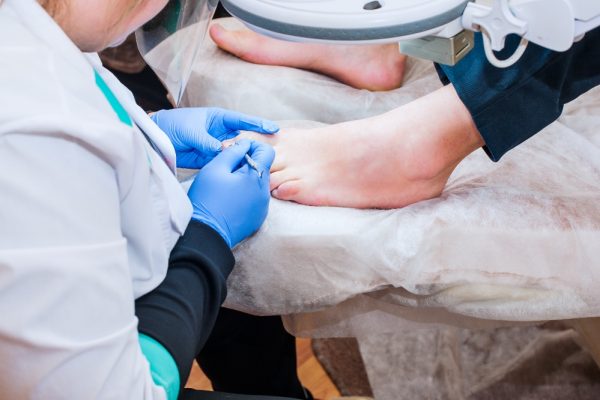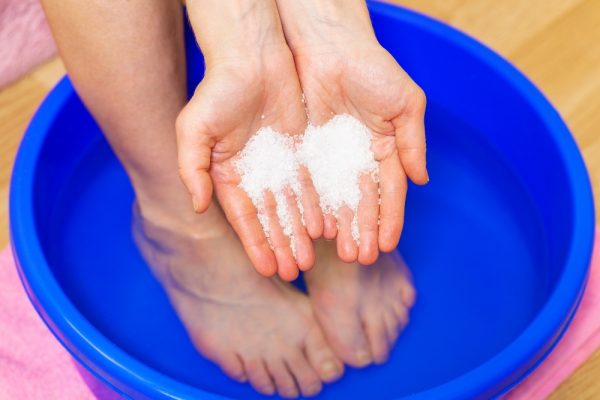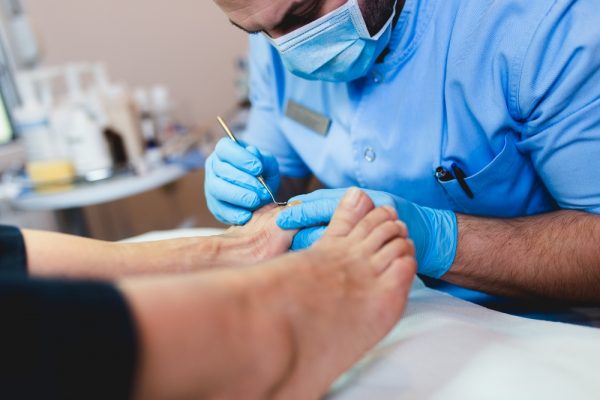An ingrown toenail is a common condition anyone can experience. It occurs when the jagged edge of the nail grows into the side of the nail bed, piercing the skin.
Eventually, the nail grows back into the skin, resulting in pain, inflammation and overall discomfort. It can happen to any toe, but is most often experienced in the big toe.
An untreated ingrown toenail can eventually lead to an infection, which can subsequently spread through the bone structure of the foot and result in substantial pain. Diabetics in particular are at higher risk.
Therefore, knowing the signs and symptoms of an ingrown toenail infection is important. Read on to learn more:

Signs of an Ingrown Toenail Infection
An infected ingrown toenail can include any or all of the following symptoms:
- Oozing or built up fluid around the affected area
- Bleeding
- Foul smell
- Heat or warmth in or around the nail bed
- Overgrowth or presence of inflamed tissues around the edges of the toenail
- Yellowing, thick or cracked nails (specifically with fungus infections)
- An abscess filled with puss, located where the jagged edge of the nail is puncturing the skin
- Throbbing
- Pain in and around the toe
- Swelling
- Pressure under the toenail
- Hardening or redness around the affected toenail
The Danger of an Infected Ingrown Toenail
There are two types of infections that can occur in the case of an ingrown toenail: bacterial and fungal infection. Either variety can become problematic, but bacterial infections like Methicillin-resistant Staphylococcus aureus (MRSA), commonly known as a Staph infection, is antibiotic resistant and dangerous.

This type of infection moves beyond impacting the immediate area of the toenail and can even spread into the bone. A serious Staph infection often requires weeks of intravenous antibiotics and in some severe cases, even surgery to treat. Therefore, at the first sign of an infected toenail, it’s vital for you to seek treatment or try some home remedies.
How to Treat Your Infected Toenail
Instead of dragging your feet, address your infected toenail as soon as possible to prevent the infection from spreading and becoming a dangerous medical issue.
At Home Remedies to Reduce Infection in an Ingrown Toenail
If you want to attempt to treat an infected ingrown toenail yourself at home, keep the following tips in mind:
- Sanitize. Before beginning any home treatment, make sure your hands are clean.
- Be gentle. Don’t pull or yank on your nail. Don’t force the skin around your toe to move.
- Take a soak. Soak the foot in warm water and Epsom salts in order to soften the infected area. This will also reduce your pain and encourage puss drainage.

- Fight infection. Apply antifungal or antibiotic lotion to the skin around and directly on the skin, under the nail and around the nail bed.
- Medicate. To reduce symptoms of swelling and discomfort, take over-the-counter medication for pain.
Try these home remedies for at the most a few days. If you do not notice a significant improvement in your symptoms, it’s time to plan a visit to the podiatrist.
In Office Treatments
The following are the most likely treatment options for an infected ingrown toenail:
A Toenail Lift
If the infected nail is only slightly ingrown, meaning the nail hasn’t buried itself deep into the side of your toe, we might be able to simply lift the edge of the nail. After it is lifted, we can place a splint, dental floss, or cotton underneath the nail to separate it from the toe.
This option changes the way your toenail grows, encouraging it to extend above the edge of the skin. This treatment option will need to be performed daily at home, meaning you will need to replace the material daily after soaking your toe.
Partial Nail Removal
If your infected toenail is more severe, a partial removal of your toenail might be the best course of action. This procedure involves our professionals numbing the area in and around the ingrown nail, then removing the ingrown portion of your nail.

Tissue or Full Nail Removal
A severely infected ingrown toenail or an ingrown nail that has grown that way time and time again demands a more aggressive approach. During this procedure, a podiatrist will remove the portion of the nail that is ingrown as well as the underlying tissue or nail bed.
The doctor will usually also apply a chemical to the area that will impede nail growth and reduce the risk of recurrence. Of course, before the process begins, they will numb your toe to make the procedure as painless as possible.
After the procedure, the doctor will wrap it up and give you post-surgical instructions to properly care for the area. Here at Foot & Ankle, we often want to see you two-weeks after your procedure to ensure your toe is healing properly and is no longer infected.
We sometimes recommend the use of oral or topical antibiotics in the case of a substantial ingrown toenail infection, but this is not common.
Lifestyle Changes to Prevent Recurrence
To reduce your risk of experiencing an ingrown toenail and subsequent infection ever again, embrace the lifestyle changes listed below:
- Wear properly fitted shoes. Your shoes should give your toes adequate room to move around and not jam together. Read our blog “5 Shoe Shopping Tips for Finding the Right Fit” for tips straight from our podiatrists.
- Trim toenails properly. Never cut your toenails too short or at a diagonal. Trim your toenails straight across to prevent the nail from growing improperly into your nail bed. Diabetics in particular need to be cautious when trimming their toes.
- Skip the pedicure. We have an article all about why most salons breed infections and how to prevent them— all while still caring for your toenails. Check it out: “10 Ways to Avoid Pedicure Infections.”
- Seek advice. If you have poor circulation in your feet or have other risk factors for ingrown toenails, you should get regular checkups to ensure optimal foot health
Maybe infection isn’t your problem, but that dreaded ingrown nail won’t go away. If you’ve had an ingrown toenail before, you may be surprised to learn that you can help to prevent recurrence. Check out our article on “6 Ways to Keep an Ingrown Nail From Growing Back” for more specific advice.
We Are Ready to Help
There’s no reason to suffer with the pain and swelling associated with an infected ingrown toenail. Allowing an infection to progress can lead to severe complications and life impacting medical conditions.
If your home remedies aren’t effectively treating your infected ingrown toenail, contact us today at 239-936-5400 to set up an appointment.
Our dedicated staff of foot and ankle surgeons, with over 30 years of experience, are often able to see you day of if you are experiencing significant pain. Call us today to address and treat your infection or other foot problems.
Categorized in: Blog